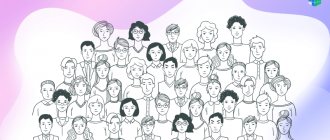Human civilization is a product of creativity, so creative individuals are always in the spotlight. Not only philosophers and psychologists, but also people far from philosophizing thought about who all these creators of masterpieces and talented scientists are, and how they differ from ordinary people. Maybe these are geniuses endowed with a divine gift, or madmen whose brains work with serious deviations? Or perhaps they are ordinary people, and the ability to create is available to everyone?
Despite serious research in the field of psychology of creativity that was carried out throughout the 20th century, there is no clear answer to these questions. But I will try to introduce you to the most common approach to understanding the essence of a creative personality.
Psychological portrait of a creative personality
Summing up this difficult topic, I want to summarize everything that has been said and present a unique psychological portrait of a creative personality. Of course, creatives are all different and differ from each other more than the average person, but they still have common features:
- The need for creativity, which largely controls the life of a creative person: choice of profession, hobby, circle of friends, etc. This need is paramount and is often satisfied even to the detriment of other vital needs.
- The desire for self-realization. This is another, no less significant need that encourages a creative person to look for himself in different types of activities, and, having found an area of application of his talent, to devote all his time to what he loves.
- High activity and performance. This activity is related to the area of creativity and is not always social, since creative individuals often do not adapt well to society.
- A special type of thinking allows a creative to see the unusual in the ordinary, find non-standard solutions and get to the goal in their own, original ways. This cannot but cause bewilderment among others, which is why creative individuals are often considered eccentrics.
- A high level of imagination and creative thinking make creatives desirable members of any team, but they also prevent society from accepting a creative person, causing a feeling of alienation in relation to the “upstart”, “strange person”, “the smartest”, etc.
- Persistence, pursuit of goals and passion for creativity allow a creative person to develop special abilities in various types of activities and become a Master. And this also makes him stand out from the crowd.
It seems that creativity is opposed to a society, the majority of whose members do not strive for creative activity. Until recently this was very noticeable. But the 20th century, with its focus on dynamic and creative development of literally all areas of life, forced a change in attitude towards creatives. Not only have they become necessary in any team, but there are also significantly more creative individuals themselves than there were 100 or even 30 years ago.
You surround yourself with beauty
As you know, talented people are talented in everything and you are no exception. You try to find your unique style in everything, from decorating your home to cooking dinner. For you, life consists of a means of self-expression and you remain true to yourself, regardless of the opinions of others about your activities. Moreover, criticism only motivates you, forcing you to stick to your line even more confidently. As John Wooden, the famous basketball player and successful basketball coach, said:
“Whatever you do, surround yourself with smart people who will argue with you.”
Observation
For the vast majority of creators, the sources of their brilliant ideas are somewhere in the real world. Therefore, people with a creative streak tend to have a fairly well-developed ability to observe: people, phenomena, events, even objects. Moreover, this observation, as a rule, is carried out very deeply and closely, and allows one to notice nuances that do not lie on the surface.
Thanks to observation, a person distinguishes signs and objects that have minor differences, notices differences in similar things, and can reduce to a minimum the time of perception of a sign, object, process. Creative people, due to their profession, in any case have developed powers of observation. They tend to notice details. And absolutely everything - be it details of a painting, film or work of art. Evgeniy Tsvimadze
You are easily distracted
In a sense, the opposite conclusion to the previous one was made by American scientists. According to the results of their study Creativity and sensory gating indexed by the P50: Selective versus leaky sensory gating in divergent thinkers and creative achievers. , creative individuals are more easily distracted by extraneous signals. Marcel Proust comes to mind, locking himself in a cork-lined room and wearing earplugs to work in silence.
Researchers note that increased sensitivity can be useful for creators: with its help, they can feel the world more subtly. But at what cost!
Biological and social in the structure of a creative personality
The debate about what determines the ability to be creative—innate characteristics or the social environment—has not subsided to this day. And this is not simple curiosity. After all, if the biological factor is decisive, then creative people are truly chosen, and education does not play a significant role. And if the social factor comes first, then every person at any age can develop creative abilities, the main thing is that the conditions are suitable.
I like the second point of view better, but I cannot help but recognize the obvious connection between creativity and the innate, genetically determined characteristics of the functioning of the brain and the body as a whole.
Biological preconditions for creativity
Research into the biological characteristics of creative individuals was carried out by serious scientists and research teams. Higher nervous activity, brain biochemistry, metabolism, and much more were studied. Based on these studies, the following biological features of creatives were identified:
- The uniqueness of brain activity, which is expressed in the predominant activity of the right hemisphere, which is responsible for imaginative thinking. True, his increased activity is typical precisely for periods of creative upsurge.
- The production by brain cells of an increased amount of certain substances that improve performance, increase the tone of the nervous system, stimulate memory, attention, etc. For example, these include the hormones acetylcholine, glutamate, dopamine.
- Increased levels of uric acid in the body, the effect of which is similar to known stimulants of mental activity, such as caffeine.
- Features of temperament. The mobility and sensitivity of the nervous system, which provides creative individuals with sensitivity to external stimuli, the ability to quickly switch attention and flexibility of thinking. On the other hand, this same feature causes frequent mood swings, increased emotional excitability and, as a consequence, the danger of professional burnout.
These biological characteristics of creatives also have a downside. They not only provide high creative activity and performance, but also lead to the fact that a person has poor control over his activities, forgets about sleep, rest, and sometimes even food. Therefore, creative individuals often suffer from mental and physical overload and increased emotionality. Creatives are also characterized by various illnesses that are not directly related to creativity, because, absorbed in the creative process, these people often do not pay attention to their physical condition.
Social factors
And yet it is impossible to say unequivocally that the ability to create is biologically given. Moreover, changes in the body of creatives may not be the cause, but a consequence of increased creative activity. Except, of course, for innate temperamental traits.
The social environment and the influence of society play no less, and perhaps even a greater role in the formation of creativity. First of all, we are talking about education, but we will not dwell on the education of a creative personality, since this is a topic for a separate discussion. Most children are born with a clearly expressed need for creativity, which they satisfy even despite the prohibitions of society. For example, they color the wallpaper with a felt-tip pen, trim the cat's hair, or take toys apart to find out how they work. But whether this need will continue, whether the children’s abilities will be developed, depends on their parents, educators, and teachers.
But for adults, the social environment is also important. Creativity is generally social; it requires evaluation, support from society, or at least criticism. And in oblivion, in the absence of the attention of others, the need for creativity and the desire to develop one’s abilities quickly fade away. It is not without reason that various types of creativity have recently become so widespread, and not only the completely democratic arts and crafts. The Internet has given everyone the opportunity to try themselves as artists, sculptors, writers, creators of worlds and crazy ideas. After all, now we can share the results of our creativity with a huge number of people, even those living thousands of kilometers away from us.
Daydreaming
Creative people are inevitably a little associated with “head in the clouds,” and for good reason: they really love to dream. These dreams can be either abstract and practically impossible, or quite concrete and achievable. The main thing is that they exist, because without them it is very difficult for such people. The absence of dreams in a creative person, as a rule, is observed only when he is depressed or in another similar state.
We all love to dream as children, but as we get older we try to limit our flights of fantasy. But it’s wrong to forbid yourself to dream. Dreams can have a positive impact on our lives if we direct them in the right direction. And dreams, they usually inspire us, and if you don’t know how to dream, if you lose this ability, you lose inspiration and, in general, the desire to live. Dreaminess is probably one of the drivers that helps creative people constantly develop in their creative path. Evgeniy Tsvimadze
You are sarcastic
Despite the fact that sarcasm is considered the most unpleasant form of wit, it requires significant mental effort.
Franco-American study The highest form of intelligence: Sarcasm increases creativity for both expressers and recipients. showed that participants in a sarcastic conversation activate abstract thinking and enhance creativity. An additional conclusion that scientists have come to is that sarcasm provokes conflict between people who are not very close, but this does not happen with those who have established trusting relationships. So feel free to troll your friends - it will only benefit your creative side.
Developed sensory sphere
A creative person is unthinkable without the widest range of feelings that he is capable of experiencing. It is impossible to create successfully or have the prerequisites for this, being an emotional “cracker”. Therefore, if you are prone to creativity, then you can probably notice a very impressive set of experiences behind you. This does not have to have clearly defined external manifestations: you can suppress your feelings - however, inside you, all the events that happen should find a very strong response.
Read also: Colors in Italian
I have never met any “crackers” among creative people. Most of them are extroverts and let all the colors of perception pass through them, accordingly. Therefore, they have a very strongly developed sensual component, and it is this that helps in many ways to find inspiration - their Muse. Evgeniy Tsvimadze
You are open to different people and ideas
Collective intelligence researchers claim Innovation in the collective brain. : innovation is the product not of talented individuals, but of many. In other words, innovation comes from communication and the exchange of ideas.
One of the study's authors urges: if you want to be more creative, talk to people you disagree with.
You don't have to take these words literally. But if you're truly open to hearing and listening to different opinions, you're likely to have a better chance of creating something breakthrough.
Intrinsic motivation
Creative people cannot help but create . This is probably their main distinguishing feature. Creativity is their state of mind, their way of life. All other things fade into the background when inspiration .
Passionate passion for work helps create masterpieces that the whole world admires
Creators are driven more by internal motivation rather than material reward. Money is a nice bonus. Typically, agents promote geniuses.











